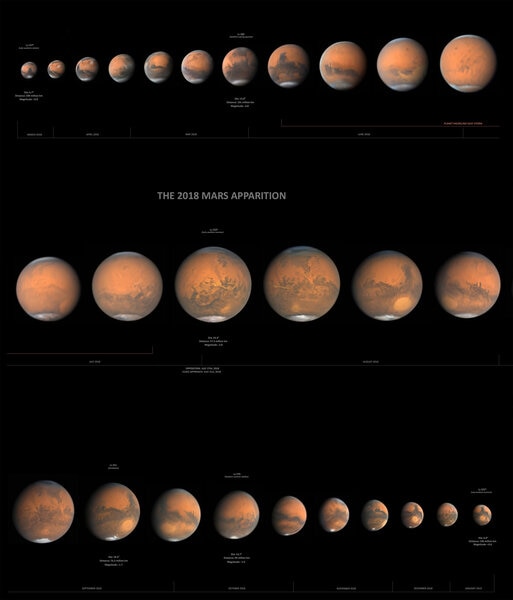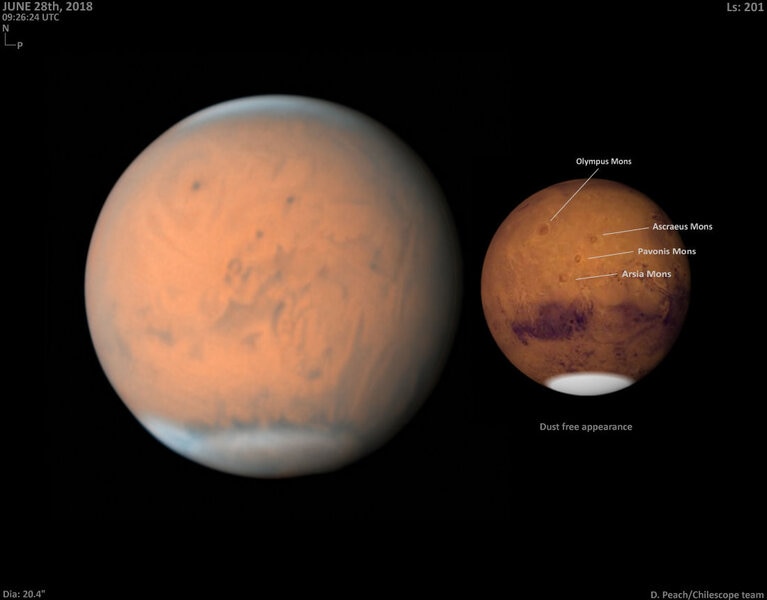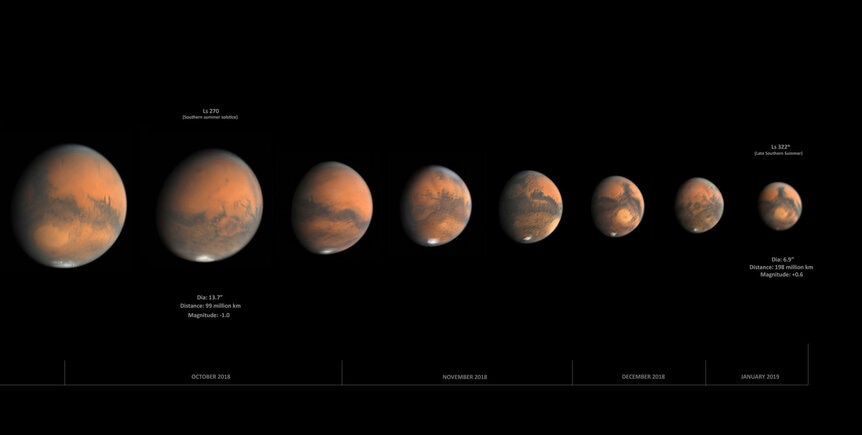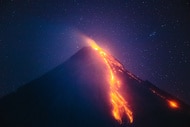Create a free profile to get unlimited access to exclusive videos, sweepstakes, and more!
The year in Mars
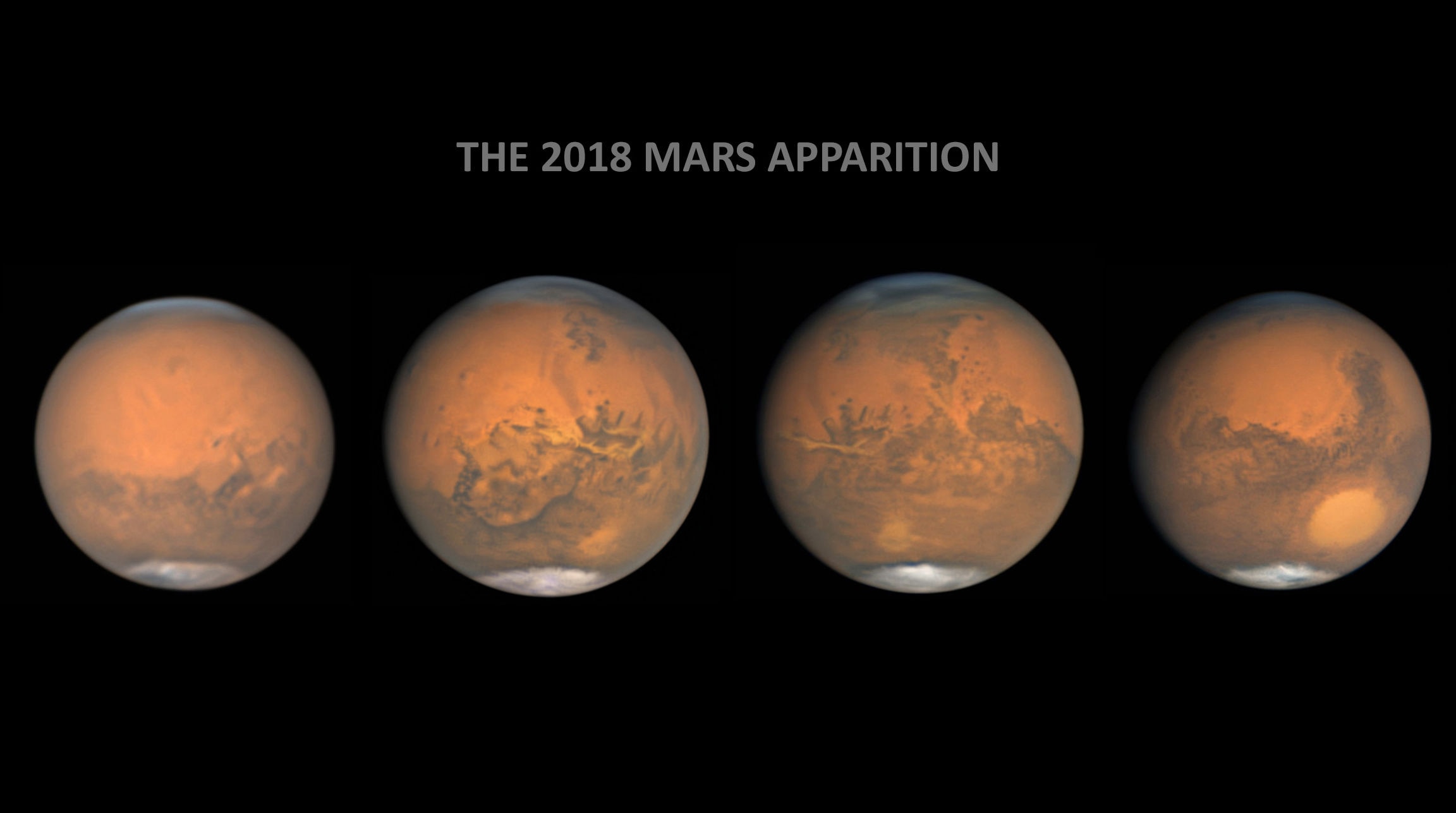
I'm always a bit torn when someone asks me to point my telescope at Mars.
I want to show them the planet. It's Mars, the Red Planet, famed in fiction and fact, shining down from the sky like a bloody eye, a baleful gaze that removes all doubt why the ancients regarded it as the god of war. Who wouldn't want to see it through a telescope?
But then there's Mars the actual planet: Half the size of Earth, and at best well over 50 million kilometers away. On average it's more like 150 million, and at worst 400 million. That's a long way for a small planet, and the views of it can be… disappointing. A red blob, fuzzed out by our atmosphere's motion, with maybe a dark splotch on it barely visible if you squint.
But then, I'm not Damian Peach.
He's an astrophotographer based in the UK, and regular readers are familiar with his astonishingly dramatic images of comets, Jupiter, and Saturn. When I get an email from him I always know it's worth a click to see what he's up to.
And when I saw the subject line yesterday — "Mars 2018 apparition overview" — yeah, I clicked that one really fast.
And holy cow, am I glad I did. Using a remotely controlled 1-meter telescope in Chile, he took a series of images of Mars over the course of 2018 and into 2019, showing its appearance, to scale, as Earth caught up and passed it in their mutual orbits, making Mars appear small, then bigger, then yegads bigger, then smaller once again.
The image itself is sizeable: 10,547 x 1,500 pixels. Here's what it looks like, though note the original is much bigger!
Cooooool. But Mars looks tiny! That's because I had to shrink it to get the software to display it. To help you, I sliced the image up into three pieces and stacked them so you can see things better (but note you STILL want the original, which is much bigger):Whoa. So what's going on here?
"Apparition" is the term astronomers use for the appearance of an object over some course of time. For Mars, it means when it first appears west of the Sun in the morning sky, after being lost in the glow. Earth moves faster in its orbit, so we catch up to it and pass it. When we're closest to it and it's opposite the Sun in the sky we say it's at opposition. It rises at sunset and becomes an evening object. After that the Earth pulls ahead, Mars recedes, and some months later approaches the Sun from the east until it's lost in the Sun's glare once again, this time at dusk.
In Peach's montage, we start on the left when Mars was moving away from the Sun in the morning. In March 2018 it was over 200 million kilometers from Earth, and appeared small. He gives the size of the planet (its diameter) in arcseconds, which is an angular unit. 1 degree = 60 arcminutes = 3,600 arcseconds. The Moon is half a degree across, so about 1,800 arcseconds, for comparison.
He also gives a term called Ls, which is the longitude of the Sun seen on Mars. Think of it as the season: On the date of the northern hemisphere's vernal equinox, the solar longitude is 0°. On the summer solstice it's 90°, fall equinox 180°, and winter solstice 270° (and reverse the seasons for the southern hemisphere). The first image has an Ls of 137°, so it's late summer in the northern hemisphere, late winter in the southern.
From our viewpoint, in this montage we see the north pole of Mars tipped away from us, so the south polar ice cap is visible at the bottom.
As you follow the sequence to the right, Mars gets bigger as we approach each other. The features on Mars change depending on the time of night Peach took an image; Mars rotates once every 24 hours 30 minutes or so, so we see a different part of it even after a few hours. If he observed 30 minutes later every night he'd see the same features every time, but if he observed earlier or later than that different spots would be in view.
Then, in June 2018, disaster: A massive dust storm started up, becoming global rapidly. It was so huge and thick it hid nearly everything from our view! It raged for weeks, obscuring everything, until September when it died down. There were times some features were visible in July, but so much was still fuzzy that even with a map I had a hard time identifying some features.
Opposition was in late July, and you can see Mars appears biggest then. This was when things started warming up in the southern hemisphere, and over the rest of the images you can see the south polar cap shrinking (though the planet itself gets smaller, so it's a little tricky to compare). Eventually, you get all the way to the right, in January 2019. At this point Mars is getting closer to the Sun in the sky, in the sky to the southwest after sunset. It's nearly 200 million km away again, and looks much the same as it did in the first image, except the south pole has vastly retreated.
There's a lot of stuff to see in between, though. In late August the gigantic Hellas Planitia is visible as the pale round area, an enormous impact basin well over 2,000 km across! Visible above it is the snake-like Syrtis Major, a dark basaltic volcanic plain. That's one of the few features I can reliably pick out with my own telescope.
What else do you see? Try comparing the images to those in an atlas (on the bottom right, click the layers button, then enable "Nomenclature" to get names). It's not as easy as you might think.
Right now, Mars is dwindling, and once it goes behind the Sun it won't be back until early winter 2019, and even then you won't see it unless you get up before the dawn.
And even if you do see it, it almost certainly won't look like this. It's amazing what can be done today, using modern telescopes, digital cameras, sophisticated techniques to process the data, and of course a master like Peach behind it all.
Still…
Next year, when the orbits match up better, the weather is nicer here, and Mars appears at a more civilized time of night, I may haul out my own 20 centimeter 'scope and take a look myself. I know it won't be as glorious as Peach's images, but then, I'll be seeing it with my own eyes, the light from the Sun reflected off the Martian surface, then traveling all those millions of kilometers to me.
Small and fuzzy? Sure, it will be. But it'll be my view, and that's why, inevitably, when someone asks, I'll happily point my telescope toward the fourth planet.

